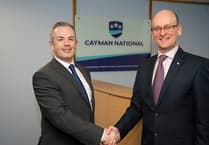A government department knowingly dumped toxic silt at sea, against the advice of a marine scientist employed by another government department.
This came to light as part of an employment tribunal which pitted Dr Kevin Kennington against the Public Service Commission (PSC).
The tribunal’s report also reveals that the dump in question ‘caused serious damage to the local fishing industry’.
Contractually, Dr Kennington’s employer was the PSC, however he was stationed in the Department of Environment Food and Agriculture (DEFA) of which Richard Lole was then the chief executive officer.
As a marine scientist of ‘considerable skill and experience’ Dr Kennington had been employed as a marine monitoring officer at the public analyst’s laboratory from 2012 until he resigned on February 7, 2020.
Before that, since 2009, he had worked as a scientific officer within the fisheries directorate of the DEFA.
While the employment and equality tribunal unanimously agreed that Dr Kevin Kennington was not constructively dismissed by the PSC, details within its findings shed a light on the practices of the Department of Infrastructure with regards to dumping at sea.
Under the Water Pollution Act 1993 (WPA), the DoI holds the territorial seabed and has lead responsibilities for it, but DEFA is responsible for the marine element.
And under the licensing regime at the material time, the DoI had the authority to issue licences for deposits of silt at sea, which ‘may or may not be contaminated and toxic to marine life’.
Therefore, before the DoI can dump silt at sea, it must present its proposal to the DEFA.
The DEFA must then consider and deliver an opinion on the rights or wrongs of the proposal, but the department’s only right is to be consulted on whether a licence to dump silt should be granted.
Additionally, DEFA has no powers to require or to ensure compliance with the WPA or other international conventions concerning dumping of waste at sea.
Despite being consulted, DEFA had no right or power to stop the DoI proceeding with dumping.
As the tribunal report stated: ‘If, contrary to the views of DEFA, the DoI proceeds with illegal dumping, then that is a burden for their officers.’
In the case of Peel marina and harbour, tests had shown that the dredged waste was toxic and could be harmful to the marine environment.
In 2013, DEFA was consulted by the DoI regarding a proposal to dredge in the area of Peel harbour.
The DoI planned to buy a cutter suction dredger (CSD) to use for dredging and subsequent dumping.
The tribunal ‘concluded on the evidence that the DoI had a serious problem to resolve. Doing nothing about the build-up of (toxic) silt was not an option’.
A suggestion was made that there could be a ‘trial dump’.
Despite the views of Dr Kennington, who was against this action, and told the tribunal that his opinion was supported by all other involved DEFA officers, Mr Lole accepted this concept.
Although it was not his final decision to make, ‘he respected the problems faced by the DoI and the need for a solution’.
Dr Kennington considered that any significant dredge to sea would be an environmental risk and would breach international obligations and the WPA.
In the summer of 2013, Anne Reynolds was appointed director of ports (within the DoI) with responsibility for the marinas.
Despite input from DEFA, including potential options and recommendations to undertake an Environmental Impact Assessment before going ahead, Ms Reynolds determined to proceed with pumping the material to sea.
There then followed debates and a modelling exercise regarding the location of dumping.
Mr Lole wanted to find a way of helping the DoI to a solution.
However, Dr Kennington was unable to indicate any safe tonnage to dump.
In Dr Kennington’s opinion, dumping any quantity at sea would be illegal.
Karen McHarg, the director of fisheries (part of DEFA), was also opposed to any dredge to sea. Mr Lole acknowledged that those in the fisheries team, headed by Karen McHarg, were also cautious about the method proposed for the trial dredging.
Nevertheless, she still had to write the letter to the DoI enabling the trial discharge of 6,000 tons of sediment, which went ahead in May 2014.
The report goes on to state that: ‘After conclusion of the trial dump, Mrs McHarg, Dr Peter Duncan and Dr Fiona Gell continued to impress upon Mr Lole (and others) the risk to the island’s fisheries as a consequence of any further disposal at sea.
‘The tribunal was not required to investigate any of this but the evidence seemed clear that, as Dr Kennington had expected, the dump had caused serious damage to the local fishing industry.’
By late June 2014, Dr Kennington had set up a monitoring programme to investigate the impact of the first dredge and dump.
He informed the Fisheries Directorate that he had found extremely high concentrations of toxins.
Dr Kennington was satisfied that it was the dredging and dumping exercise that had caused the problem.
He pointed out the high possibility of damage to the King Scallop population in the west coast fishing grounds.
The scallop grounds had to be closed for a number of months during the winter of 2014-2015.
Dr Kennington alleged that he had been constructively dismissed because of his protected disclosures (whistleblowing).
For instance, on November 28, 2016, he challenged the legality of further dumping and highlighted its adverse impact on fisheries by approaching the Attorney General.
He explained his concern about marine pollution, and this led to obvious consequential action as the dredging and dumping programmes were both halted.
Dr Kennington also alleged a variety of mistreatment, including gaslighting, exclusion from meetings and being unfairly criticised and challenged.
However, the tribunal declared on June 15 that ‘Dr Kennington had not proved that he was unfairly constructively dismissed’.




-(1).jpeg?width=209&height=140&crop=209:145,smart&quality=75)